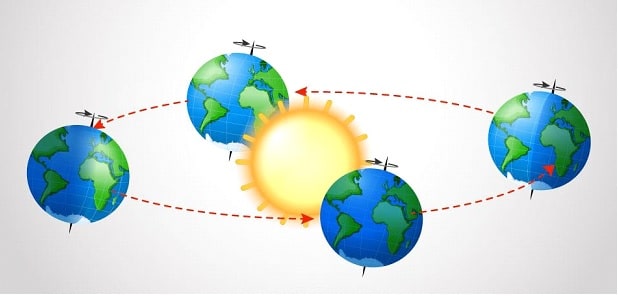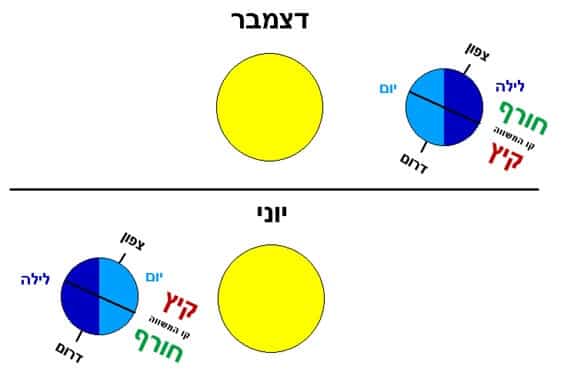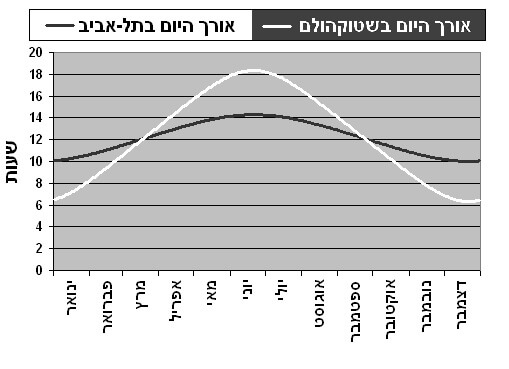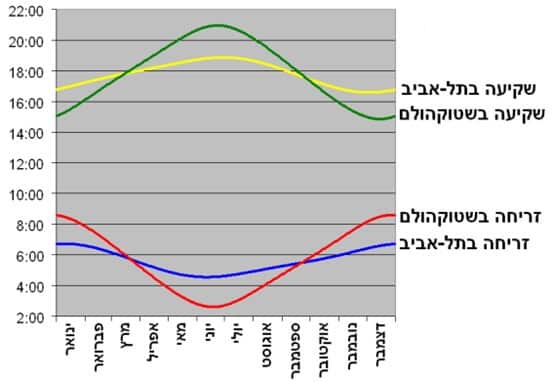On the occasion of the winter solstice starting today, Dr. Nadia Goldovski - the person in charge of time and frequency measurements at the National Physics Laboratory at the Ministry of Economy and Industry - explains how to calculate exactly when the moment of the solstice falls
The first day of winter (winter solstice or December solstice) is when the sun is in its southernmost position directly above the circle of Capricorn.
Astronomical winter begins at different times around the Earth due to the different time zones. Those located west of zero longitude - Greenwich will start winter earlier than countries located east of this line. According to the astronomical calculators, winter will begin today, December 21, 2021 at about ten minutes to midnight. (23:48 p.m. for viewers from the center of Israel)
Astronomical and meteorological winter
the winter The astronomical is determined by the changing position of the earth in relation to the sun which gives us the solstices and equinoxes. The seasons are caused by the Earth's tilt on its axis by 23.5 degrees. The Earth's tilt does not change as it orbits the Sun, so the Northern Hemisphere is tilted toward the Sun in June and away from it in December.
When the sun is above the equator, the equinoxes occur, and when the sun is above the circle of Cancer in its northernmost position, the summer solstice occurs, and on the other hand, when the sun is above the southernmost position in the group of Capricorn, the winter solstice occurs.
The winter solstice occurs in the northern hemisphere between December 20-23, followed by the vernal equinox - March 19 to 21, the summer solstice - June 20 to 22, and finally the autumnal equinox - September 21 to 23. The United States, most of North America, Europe, and many countries in the Northern Hemisphere use the astronomical winter definition to determine when the winter season officially begins and ends.
The meteorological winter determined by annual temperature cycles and the calendar. The meteorological winter begins on December 1 in the northern hemisphere and lasts for 3 months (December, January and February) with the spring season (March, April and May) and the summer season (June, July and August) and finally the autumn season (September, October and November). Australia and New Zealand in the southern hemisphere use meteorological winter so June, July and August to determine their winter season.
However, the exact definition of the concept of the winter season varies from country to country according to its specific climate. It now seems that it will also change according to the effects of the climate crisis. Although the earth will not move further or closer to the sun, it will get hotter and hotter. In Israel, for example, they estimate May the winter be shortened and extreme weather events such as the storm Carmel that we are in the midst of will increase and multiply.
Tomorrow, December 21st is the shortest day of the year. On this day the day is the darkest, meaning that the hours of darkness are more than the hours of the day. On this day the winter season begins in the Northern Hemisphere.
Starting from December 21, the days in the Northern Hemisphere start to get longer and the nights get shorter. On this day the sun is also the lowest of the year. In the southern hemisphere, the exact opposite happens and from this day on, the day is the longest and the days will get shorter and shorter.
On the shortest day of the year on December 21, the length of daylight hours amounts to 10 hours and 3 minutes, and on the longest day of the year on June 21, the length of daylight hours amounts to 14 hours and 14 minutes.
"The shortest day of the year" is called that because there are fewer hours of light, the day is the shortest and the night is the longest of the year.
What are the solstice days?
Dr Nadia Goldovsky - The person in charge of time and frequency measurements at the National Physics Laboratory at the Ministry of Economy and Industry, explains:

Today we know that the Earth revolves around the Sun, and around itself on a fixed axis - so the North Pole always faces the North Star, which is outside the Solar System. Therefore, in the Earth's orbit around the Sun, on one side of it, its northern hemisphere is inclined towards the Sun (Figures 1 and 2) and therefore receives direct radiation, which heats it up a lot. These are the summer days in the Northern Hemisphere. On the other hand, further along its path around the sun, on the other side of it, the northern hemisphere is inclined in the opposite direction from the sun, and therefore receives a lower radiation intensity. These are the winter days in the Northern Hemisphere. The tilt of the Earth also affects the amount of time in a day that there is light, so the days are longer in the summer and shorter in the winter.
The length of the day does not change, what we do lose or gain (in winter or summer respectively) is hours of sunlight. In winter we get the least amount of sunlight of the year on this day.
To understand the winter and summer solstices, we need to understand a basic fact - the Earth's axis of rotation is tilted approximately 23.5 degrees compared to the plane of its orbit around the Sun (see Figures 1 and 2).

The position of the earth relative to the sun on both days of the solstice can be seen in picture 2. In December, the northern hemisphere gains fewer hours of light, and also at a lower angle of the sun, therefore there is the peak of winter, and vice versa in the southern hemisphere. In June the situation reverses.
According to the astronomical division into seasons, each season begins and ends exactly on the day on which the solstice or equinox occurs. The equinoxes are the beginning of the "transitional" seasons - spring and autumn. According to the meteorological division, a season opens at the beginning of the month when one of the two solstice points or one of the two equinoxes occurs. At the equinoxes, day and night editors are equal, this happens on March 21 and September 21.
To better understand the subject, below are graphs of day and night lengths in Tel Aviv and Stockholm.

Graph 1. The length of the day (from sunrise to sunset) in Tel Aviv compared to Stockholm.

You can see from the graphs that the shortest day is on December 21st and it is 10 hours in Tel Aviv and only 6 hours in Stockholm. The length of the longest day is on June 21 and it is over 14 hours in Tel Aviv and over 16 hours of light in Stockholm. At the equinoxes on March 21 and September 21, the length of the day is 12 hours in both Tel Aviv and Stockholm.
The sunrise and sunset times in summer and winter in both cities are very different. On the other hand, at the equinox points, both cities have the same sunrise and sunset times.
רOr also an interview with Dr. Nadia Goldovski about the use of atomic clocks in the laboratory she heads.
